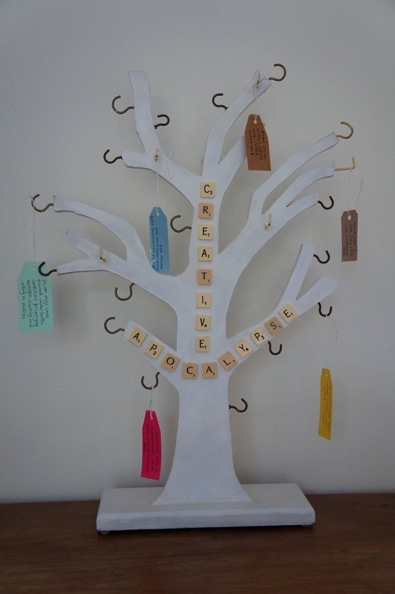
creative apocalypse
A special First World War art exhibition
Teign Heritage Centre
29 French Street, Teignmouth, TQ14 8ST
September 11th -- November 11th, 2018

Wilfred Owen
Creative Apocalypse is a celebration of some of Britain and Europe’s greatest artists and writers who lost their lives during the First World War, and the creative legacies they left behind. It is a pan-European response to the ‘Great’ War, in part an anticipation of its looming shadow and in part a response to its shell-shocked aftermath. It is a reminder, during this hundred year anniversary of the Armistice, that the war touched all sides. It is also a celebration of the artists and writers who survived, who painted and wrote about what they had witnessed and experienced.
Creative Apocalypse is the making of 9 works of mixed-media assemblage in 3
triptych's which will be exhibited at Teign Heritage Centre to run with a
Teignmouth in World War I: 2018 exhibition, from September 11th to November11th.
It is a celebration of the creative legacies of lost artists Wilfred Owen, Henri Gaudier-Brzeska, Umberto Boccioni, Franz Marc, August Macke and Georg Trakl, and the post-war works of the survivors: Paul Nash, David Bomberg, Wyndham Lewis, Ford Maddox Ford, Otto Dix, Albin Egger- Lienz, Erich Maria Remarque, and the work of the women writers who exposed the plight of the shell-shocked: Rose Macaulay, Rebecca West, Virginia Woolf and Vera Brittain.
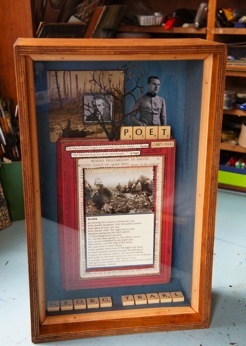
Georg Trakl
Georg Trakl (1887-1914) is considered one of the most important Austrian Expressionist poets. At the beginning of the war, he was sent as a medical official to attend soldiers in Galicia (now Ukraine and Poland). He suffered frequent bouts of depression and finally committed suicide on November 3rd, 1914, traumatised after having served in a medical unit without any anaesthetics during the violent battle of Grodek against the Russians, the title of his masterpiece.
“I drift between fear and helplessness.”
“Cold metal walks across my forehead.”
“Shuddering under the autumn stars,
each year, the head sinks lower and lower.”

Daughters of War:
A number of prominent women writers exposed the plight of the shell-shocked soldiers (and their struggle to return to ‘normal’ life after the war): Rose Macaulay in Non-Combatants and Others (1916); Rebecca West in The Return of the Soldier (1918); Virginia Woolf in Mrs Dalloway (1925) and Vera Brittain, in her cathartic memoir, Testament of Youth (1933).
From the summer of 1915, Vera Brittain had worked as a Voluntary Aid Detachment nurse in London, Malta and France. She became a committed pacifist. Her fiancé Roland Leighton, two close friends, and brother Edward Brittain, were all killed during the war.
“All that a pacifist can undertake – but it is a very great deal – is to refuse to kill, injure or otherwise cause suffering to another.” (Vera Brittain)
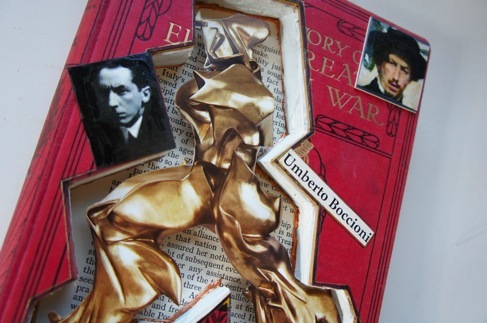
Umberto Boccioni
Umberto Boccioni (1882-1916,) the influential, Italian futurist, created intensely dynamic images which were powerful symbols for the technological breakthroughs of the new century. Futurism celebrated war as a cleansing, energising force. When war came, he joined up, was wounded in 1915, and died on August 17th, 1916 when he was thrown from his horse during a cavalry training exercise and trampled. His dynamism of form, and deconstruction of solid mass, inspired many other artists.
“We must now learn to draw inspiration from the tangible miracles that surround us.”
“A time will come when the eye of man will perceive colours as feelings.”

Franz Marc
Franz Marc (1880 – 1916,) the visionary painter and founder of the German Expressionist Blue Rider movement, captured the excitement of the century in shards and streaks of fiery colour as he re-imagined nature and complex animal life through deeply empathic eyes. But he was drafted into the German Army as a cavalryman, and struck in the head and killed by a shell splinter during the Battle of Verdun on March 4th, 1916, and modern art lost a giant in the making. Powerfully prophetic, his 1913 Fate of the Animals predicted some of the terrible animal slaughter (10 million horses alone) which lay ahead.
“I never have the urge to paint animals ‘the way I see them,’ but rather the way they are…The way they themselves look at the world and feel their being.”
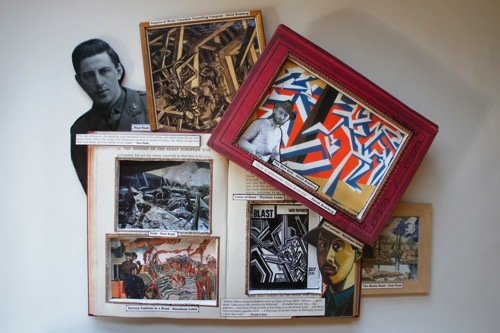
Paul Nash, David Bomberg, Wyndham Lewis, Ford Maddox Ford
Paul Nash, (1889-1946) was sent to the Western Front as an officer in February 1917. He was based on the Ypres Salient. On the night of May 25th 1917, he fell into a trench, broke a rib and was invalided back to London. Days later the majority of his unit were killed. While recuperating, he worked from sketches he had done at the Front to produce a series of drawings of the war. In November 1917 he returned to the Front as a uniformed observer. Nash was one of the most important landscape artists of the first half of the twentieth century. He played a key role in the development of Modernism in English art. His famous war works include: Wire, The Mule Track, We Are Making A New World and The Menin Road.
David Bomberg, (1890-1957) a prominent, Jewish, pre-war Vorticist, was sent to the Western Front in March 1916 as a private. The war was to have a profound effect on his outlook and art. His experience of the mechanized slaughter, the death of his brother in the trenches, as well as the death of several friends, including the poet, Isaac Rosenberg, permanently destroyed his faith in the aesthetics of the machine age. He would replace his own stark, pre-war style (“futurist abortion”) with more representational, organic work. His best-known World War I works are The Mud Bath and Sappers At Work.
Percy Wyndham Lewis, (1882-1957) American-British writer, painter, co-founder of Vorticism and editor of BLAST, was posted to the Western front in 1917. His time was spent in Forward Observation Posts looking down at apparently deserted German lines, registering targets and calling down fire from batteries massed around the rim of the Ypres Salient. It was dangerous work and he made vivid accounts of narrow misses and deadly artillery duels. He was appointed as an official war artist for the Canadian and British governments in December 1917. His war work includes A Battery Shelled and Before Antwerp.
Ford Maddox Ford, (1873-1039) half English, half German, but an English national, enlisted at the age of 41 into the Welch (Welsh) Regiment in July 1915. He was sent to France. Ford's combat experiences inspired his tetralogy Parade's End, set in England and on the Western Front before, during and after World War I. Prior to enlisting he was involved in British war propaganda, writing two books. After the war, he became a prolific, and in his time prominent, novelist. His best-known work is The Good Soldier (1915).
“What is dreadful is that the world goes on and people go on being stupidly cruel, in the old ways and all the time.”
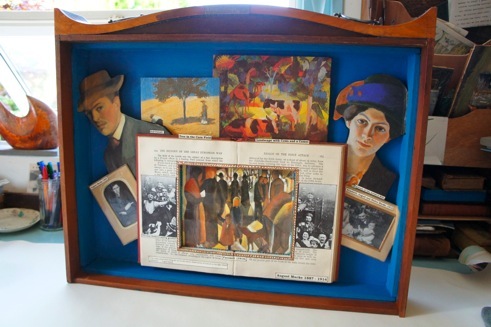
August Macke
August Macke (1887-1914,) this leading German expressionist, influenced by the French impressionists, post-impressionists and Fauvists’ passion for vibrant colour, made art that was sensual, hedonist and full of pulsing life, but his artistic joy in existence was cut short in the early, first weeks of the war. He died on September 26th, 1914 at the front in Champagne; his final painting, Farewell, having depicted the mood of terrible gloom that had settled after the war’s outbreak.
“The most important thing for me is the direct observation of nature in its light-filled existence.”
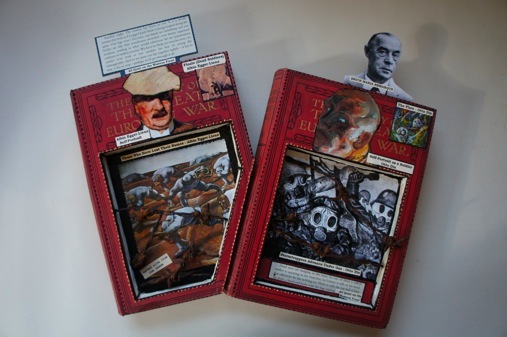
Otto Dix, Albin Egger-Lienz, Erich Maria Remarque’s
Otto Dix, (1891-1969), German painter and printmaker, was assigned to a machine-gun unit and fought in the Battle of the Somme. In November 1917 his unit was transferred to the Eastern Front and in February 1918 he was sent to Flanders. He earned the Iron Cross. After being wounded in the neck he trained as a pilot. He was profoundly affected by the brutality of war, and described a recurring nightmare in which he crawled through destroyed houses. His traumatic experiences became the maccabre, Trench Warfare, Stormtroopers Advancing Under Gas and fifty etchings, Der Krieg, published in 1924. Dix was a key artist of the New Objectivity movement. Under the Nazis he was vilified as “unpatriotic” and “degenerate.”
Albin Egger-Lienz, (1868-1926) an Austrian artist who had been Professor at the Weimar School of Fine Arts, served as a war painter during World War I. His father, under whom he had trained, had been a Church painter. His work is monumental and expressive and includes the powerful Den Namenlosen, (The Nameless Ones), Toter Soldat (Dead Soldier), 1915, Kriegsfrauen (War Women) and Finale.
Erich Maria Remarque (1898-1970) was conscripted into the German Army at the age of 18. On 12 June 1917, he was sent to the Western Front. On 31 July, he was wounded in the leg, arm and neck, and taken to an army hospital in Germany where he spent the rest of the war. A novelist, he wrote many works about the horrors of war, the best-known of which were his anti-war story, All Quiet On The Western Front (Im Westen nichts Neues, 1928) which became an Oscar-winning film, its sequel, The Road Back (Der Weg zurück, 1931) and A Time to Love and a Time to Die (Zeit zu leben und Zeit zu sterben, 1954) which also became a film. His books were burned by the Nazis, who also executed his sister, Elfriede for “defeatism.” After a few years in America, he finally settled in Switzerland.
“This book is to be neither an accusation nor a confession, and least of all an adventure, for death is not an adventure for those who stand face to face with it. It will try simply to tell of a generation of men who, even though they may have escaped the shells, were destroyed by the war.”
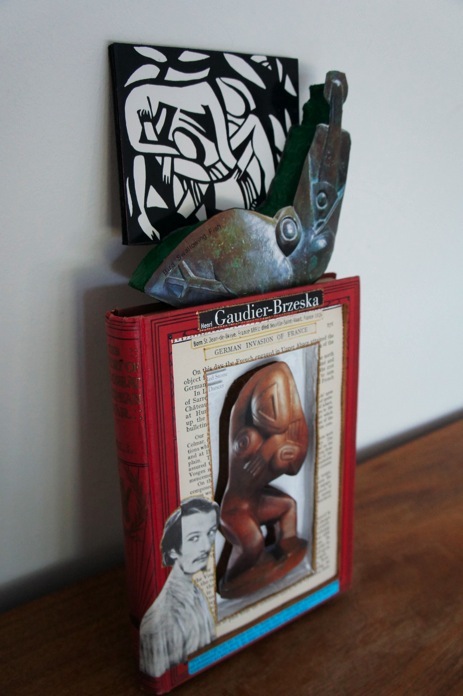
Henri Gaudier-Brzeska
Henri Gaudier-Brzeska (1891-1915,) the gifted French artist and sculptor, lived and worked in Britain, where he shared the radical modernism of friends Ezra Pound and Jacob Epstein. He was one of the signatories to the Vorticist manifesto and a key contributor to BLAST. When war was declared he joined the French army. He fought with little regard for his own safety, receiving a decoration for bravery and was killed in the trenches at Neuville-St-Vaast on June 5th, 1915, leaving a small, but formidable, body of work.
"The more I go into the woods and the fields the more distrustful I become of art and wish all civilization to the devil; the more I wander about amidst filth and sweat the better I understand art and love it; the desire for it becomes my crying need."
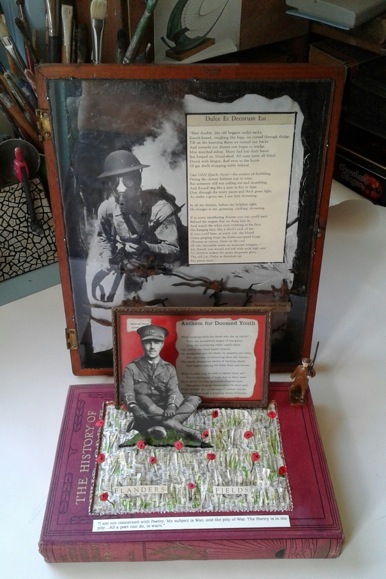
Wilfred Owen
Wilfred Owen (1893-1918,) the greatest of the war poets, exposed the horrors of the trenches and gas warfare in his best-known works: Dulce et Decorum est, Insensibility, Anthem for Doomed Youth, Futility, Exposure and Strange Meeting. He was killed in action on November 4th, 1918, a week to the hour, before the Armistice. His mother received the telegram on Armistice Day, as the bells were ringing out over Shrewsbury.
Owen came to Teignmouth in 1911 in a pilgrimage to Keats’ house. He apparently stood outside transfixed, and was inspired to write Sonnet to Keats.
“I am not concerned with Poetry. My subject is War, and the pity of War. The Poetry is in the pity…All a poet can do, is warn.”
“As an artist, these lost artists, their creative legacies, and the survivor artists
who felt compelled to reflect the hell of their experience of the ‘Great’ War, really fascinate me. There is a terrible irony that art, a creative force, should be forced to depict death, the ultimate destruction. Modernism grew out of the roots of these artists’ work, but many of them are still unfamiliar in the UK. This is a unique opportunity to celebrate their important contribution. I am so pleased to be working with the Teign Heritage Centre on this project. The two First World War exhibitions running concurrently will give visitors a real insight.
A Speaking Tree message board will encourage visitors to leave their impressions, comments, lines of poetry, peace slogans and drawings, so that a creative dialogue can be shared with others.
Art historian and artist, Kristina Bieganski will give 2, hour-long talks about the artists and their cultural legacy on Saturday 22nd of September and Saturday 13th October at 11am. The talks are free of charge. There will be an open Q and A opportunity with Derek Finch on X as part of this.
Kristina Bieganski
BA Hons Hums Degree in ART HISTORY West London University.(1987)
Since 2000 Kristina has taught C20th Art History Courses for the WEA and given Art History slide show presentations at EXETER PHEONIX ARTS CENTRE, The RED PROPELLER GALLERY (Kingsbridge, Devon) THE BREAD & ROSES in Plymouth and Birdwood House Totnes.
She has written, presented and broadcast 14 radio shows for SOUND ART RADIO -(Dartington Devon.) on the various aspects of C20th Art History movements embracing the political , socio & economic influences of the subject.
She has also worked as an experimental 3-D Mixed Media Artist/sculptress herself since 1987 and has had periodic exhibitions and worked on joint projects. Her Art work has a tendency to reflect her interest in socio political history and humanity & Outsider Art movements.
Contact and further information
Teign Heritage Centre on 01626 777041 or email: info@teignheritage.org.uk,
or Derek Finch, artist on 07944 002671 or email: dexfinch@gmail.com
Facebook page @ Creative Apocalypse Derek Finch
